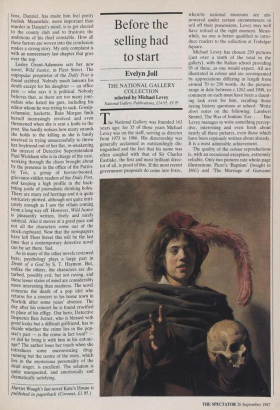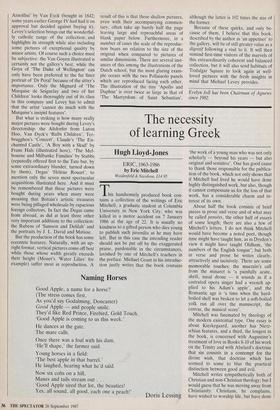Before the selling had to start
Evelyn Jo11
THE NATIONAL GALLERY COLLECTION selected by Michael Levey
National Gallery Publications, 04.95, f9.95
The National Gallery was founded 163 years ago; for 35 of those years Michael Levey was on the staff, serving as director from 1973 to 1986. His directorship was generally acclaimed as outstandingly dis- tinguished and the fact that his name was often coupled with that of Sir Charles Eastlake, the first and most brilliant direc- tor of all, is proof of this. If the most recent government proposals do come into force,
whereby national museums are em- powered under certain circumstances to sell off their possessions, Levey may well have retired at the right moment. Mean- while, no one is better qualified to intro- duce readers to the collection at Trafalgar Square.
Michael Levey has chosen 250 pictures (just over a tenth of the total in the gallery), with the Italian school providing 95 of these, as one would expect. All are illustrated in colour and are accompanied by appreciations differing in length from around 70 to 250 words. As the pictures range in date between c.1262 and 1908, to comment on each must have been a daunt- ing task even for him, recalling those taxing history questions at school: 'Write short notes on the following: Lambert Simnel, The War of Jenkins' Ear. . . .' But Levey manages to write something percep- tive, interesting and even fresh about nearly all these pictures, even those which have been copiously written about already. It is a most admirable achievement.
The quality of the colour reproductions is, with an occasional exception, extremely reliable. Only two pictures rate whole-page illustrations: Piero's 'Baptism' (bought in 1861) and 'The Marriage of Giovanni Arnolfini' by Van Eyck (bought in 1842; some years earlier George IV had had it on approval but decided against buying it). Levey's selection brings out the wonderful- ly catholic range of the collection\ and highlights its strength while also including some pictures of exceptional quality by minor artists. Of course such a choice must be subjective: the Van Goyen illustrated is certainly not the gallery's best, while the Goya of The Duke of Wellington' can only have been preferred to the far finer portrait of 'Dr Pere because of the sitter's importance. Only the Mignard of 'The Marquise de Seignelay and two of her Children' looks thoroughly out of its class in this company and Levey has to admit that the artist 'cannot do much with the Marquise's insipid features'.
But what is striking is how many really major pictures were bought during Levey's directorship: the Altdorfer from Luton Hoo, Van Dyck's `Balbi Children', Ter- brugghen's 'Concert', Claude's 'The En- chanted Castle', 'A Boy with a Skull' by Frans Hals (illustrated here), 'The Mel- bourne and Milbanke Families' by Stubbs (reputedly offered first to the Tate but, by some extraordinary blunder, turned down by them), Degas' Helene Rouart', to mention only the seven most spectacular acquisitions illustrated here. And it must be remembered that these pictures were bought during years when many were moaning that Britain's artistic treasures were being pillaged wholesale by rapacious foreign collectors. In fact the Degas came from abroad, as did at least three other very important additions to the collection: the Rubens of 'Samson and Delilah' and the portraits by J. L. David and Matisse.
But the production of the book has some eccentric features. Naturally, with an up- right format, vertical pictures come off best while those whose width greatly exceeds their height (Monet's 'Water Lilies' for example) suffer most in reproduction. A result of this is that these shallow pictures, even with their accompanying commen- tary, often take up barely half the page leaving large and reproachful areas of blank paper below. Furthermore, in a number of cases the scale of the reproduc- tion bears no relation to the size of the original when compared to pictures of similar dimensions. There are several inst- ances of this among the illustrations of the Dutch school, but the most glaring exam- ple occurs with the two Pollaiuolo panels which are reproduced facing each other. The illustration of the tiny 'Apollo and Daphne' is over twice as large as that of `The Martyrdom of Saint Sebastian', although the latter is 102 times the size of the former.
Because of these quirks, and only be- cause of them, I believe that this book, described by the author as 'an appetiser' to the gallery, will be of still greater value as a digestif following a visit to it. It will then remind first-time visitors of the marvels of this extraordinarily coherent and balanced collection, but it will also send habitués of Trafalgar Square to look again at well- loved pictures with the fresh insights in mind that Michael Levey provides .
Evelyn Joll has been Chairman of Agnews since 1982.































































 Previous page
Previous page